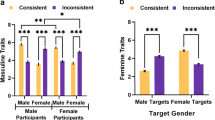Abstract
The domain of sports and physical activity has traditionally been considered to be appropriate for men and not compatible with the feminine role. Because gender-based schematic processing has been shown to affect attitudes and behavior, there might be differences in the categorization of sports as masculine or feminine, between sex-typed and non-sex-typed individuals. The findings in this study, including 104 women and 103 men (96.6% Caucasian, 2.9% Arabic, 0.5% Black) showed differences in gender appropriateness ratings between groups classified according to the Bem Sex Role Inventory, and also between men and women. Men, in general, and sex-typed men, in particular, were more inclined to stereotype sports as masculine or feminine. An explanation might be that these individuals engage to a greater extent in gender-based schematic processing. A possible additional explanation could be that childhood socialization into sports may serve as a means of providing proof of boys' manliness and the validation of prejudices against women, and that the need for this proof is stronger among sex-typed men.
Similar content being viewed by others
References
Bem, S. L. (1974). Measurement of psychological androgyny.Journal of Consulting and Clinical Psychology, 42, 155–162.
Bem, S. L. (1975). Sex role adaptability: One consequence of psychological androgyny.Journal of Personality and Social Psychology, 31, 634–643.
Bem, S. L. (1977). On the utility of alternative procedures for assessing psychological androgyny.Journal of Consulting and Clinical Psychology, 45, 196–205.
Bem, S. L. (1981). Gender schema theory: A cognitive account of sex typing.Psychological Review, 88, 354–364.
Bem, S. L. (1985). Androgyny and gender schema theory: A conceptual and empirical integration. In T. B. Sondregger (Ed.),Nebraska Symposium on Motivation, 1984: The psychology of gender. Lincoln, NB: University of Nebraska Press.
Bem, S. L., & Lenney, E. (1976). Sex typing and the avoidance of cross-sex behavior.Journal of Personality and Social Psychology, 33, 48–54.
Bem, S. L., Martyna, W., & Watson, C. (1976). Sex typing and androgyny: Further explorations of the expressive domain.Journal of Personality and Social Psychology, 34, 1016–1023.
Birns, B. (1976). The emergence and socialization of sex differences in the earliest years.Merrill Palmer Quarterly, 22, 229–251.
Birrel, S. (1983). The psychological dimensions of female athletic participation. In M. Boutilier & L. SanGiovanni (Eds.),The sporting woman. Champaign, IL: Human Kinetics.
Bray, J. H., & Maxwell, S. E. (1985).Multivariate analysis of variance. Thousand Oaks, CA: Sage Publications.
Burke, K. L. (1986). Comparison of psychological androgyny within a sample of female college athletes who participate in sports traditionally appropriate and traditionally inappropriate for competition by females.Perceptual and Motor Skills, 63, 779–782.
Cohen, G. L. (1993). Media portrayal of the female athlete. In G. L. Cohen (Ed.),Women in sport. Issues and controversies. London: Sage Publications.
Colley, A., Roberts, N., & Chipps, A. (1985). Sex-role identity, personality and participation in team and individual sports by males and females.International Journal of Sport Psychology, 16, 103–112.
Csizma, K. A., Wittig, A. F., & Schurr, K. T. (1988). Sports stereotypes and gender.Journal of Sport and Exercise Psychology, 10, 62–74.
Del Rey, P. (1976). In support of apologetics for women in sport. In R. W. Christina & D. M. Landers (Eds.),Psychology of motor behavior and sport. Champaign, IL: Human Kinetics.
Eccles, J. S., Jacobs, J. E., & Harold, R. D. (1990). Gender role stereotypes, expectancy effects, and parents' socialization of gender differences.Journal of Social Issues, 46, 183–201.
Ellis, L. J., & Bentler, P. M. (1973). Traditional sex-determined role standards and sex stereotypes.Journal of Personality and Social Psychology, 25, 28–34.
Engel, A. (1994). Sex roles and gender stereotyping in young women's participation in sport. Special Features: Doing it by degrees: Feminist undergraduate dissertations.Feminism and Psychology, 4, 439–448.
Frable, D. E. S., & Bem, S. L. (1985). If you're gender-schematic, all members of the opposite sex look alike.Journal of Personality and Social Psychology, 49, 459–468.
Greendorfer, S. L. (1977). Role of socializing agents in female sport involvement.Research Quarterly for Exercise and Sport, 48, 304–310.
Greendorfer, S. L., & Ewing, M. E. (1981). Race and gender differences in children's socialization into sport.Research Quarterly for Exercise and Sport, 52, 301–310.
Harry, J. (1995). Sports ideology, attitudes toward women, and anti-homosexual attitudes.Sex Roles, 32, 109–116.
Henschen, K. P., Edwards, S. W., & Mathinos, L. (1982). Achievement motivation and sex-role orientation of high school female track and field athletes versus nonathletes.Perceptual and Motor Skills, 55, 183–187.
Kane, M. J., & Greendorfer, S. L. (1994). The media's role in accommodating and resisting stereotyped images of women in sport. In P. J. Creedon (Ed.),Women, media and sport: Challenging gender values. Thousand Oaks, CA: Sage Publications.
Kane, M. J., & Snyder, E. E. (1989). Sport typing: The social ‘containment’ of women in sport.Arena Review, 13, 77–96.
Kohlberg, L. A. (1966). A cognitive-developmental analysis of children's sex-role concepts and attitudes. In E. E. Maccoby (Ed.),The development of sex differences. Stanford, CA: Stanford University Press.
Locksley, A., Borgida, E., Brekke, N., & Hepburn, C. (1980). Sex stereotypes and social judgement.Journal of Personality and Social Psychology, 39, 821–831.
Matteo, S. (1986). The effects of sex and gender-schematic processing on sport participation.Sex Roles, 15, 417–432.
Matteo, S. (1988). The effect of gender-schematic processing on decisions about sex-inappropriate sport behavior.Sex Roles, 18, 41–58.
McGuire, J. (1988). Gender stereotypes of parents with two-year-olds and beliefs about gender differences in behavior.Sex Roles, 19, 233–240.
Mead, B. J., & Ignico, A. A. (1992). Children's gender-typed perceptions of physical activity: Consequences and implications.Perceptual and Motor Skills, 75, 1035–1042.
Messner, M. A. (1988). Sports and male domination: The female athlete as contested ideological terrain.Sociology of Sport Journal, 5, 197–211.
Messner, M. A. (1990). Men studying masculinity: Some epistemological issues in sport sociology.Sociology of Sport Journal, 7, 136–153.
Ostrow, A. C., Jones, D. C., & Spiker, D. D. (1981). Age role expectations and sex role expectations for selected sport activities.Research Quarterly for Exercise and Sport, 52, 216–227.
Pedersen, D. M., & Kono, D. M. (1990). Perceived effects on femininity of the participation of women in sport.Perceptual and Motor Skills, 71, 783–792.
Sabo, D., & Messner, M. A. (1993). Whose body is this? Women's sports and sexual politics. In G. L. Cohen (Ed.),Women in sport. Issues and controversies. Thousand Oaks, CA: Sage Publications.
Salminen, S. (1990). Sex role and participation in traditionally inappropriate sports.Perceptual and Motor Skills, 71, 1216–1218.
Schmitt, B. H., & Millard, R. T. (1988). Construct validity of the Bem Sex Role Inventory (BSRI): Does the BSRI distinguish between gender-schematic and gender-aschematic individuals?Sex Roles, 19, 581–588.
Snyder, E. E., & Spreitzer, E. (1983). Change and variation in social acceptance of female participation.Journal of Sport Behavior, 6, 3–8.
Author information
Authors and Affiliations
Additional information
This research was partly supported by a grant from the Swedish National Center for Research in Sports (No. 10/95).
Rights and permissions
About this article
Cite this article
Koivula, N. Ratings of gender appropriateness of sports participation: Effects of gender-based schematic processing. Sex Roles 33, 543–557 (1995). https://doi.org/10.1007/BF01544679
Issue Date:
DOI: https://doi.org/10.1007/BF01544679




